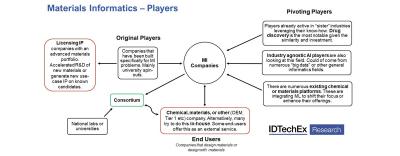This is a sponsored post by IDTechEx
Materials Informatics is the key to enabling a paradigm shift in our approach to materials science R&D. Significant investment, notable adoption from key end-users, and technology leaps make it evident that its time has come. Through primary-interview based analysis, IDTechEx has introduced the most comprehensive market report on the topic: Materials Informatics 2020-2030.
What Is Materials Informatics?
Materials Informatics (MI) is the use of data-centric approaches for the advancement of materials science. This can take numerous forms and influence all parts of R&D (hypothesis data handling & acquisition data analysis knowledge extraction).
MI can accelerate the forward direction of innovation (properties are realised for an input material), but the idealised solution is to enable the inverse direction (materials are designed given desired properties).
This is not straight-forward and is still at a nascent stage. In many cases, the data infrastructure is not comprehensive and ML algorithms are often too immature for the given experimental data. The challenge is not the same as in other AI-led areas (such as autonomous cars or social media), the players are often dealing with sparse, high-dimensional, biased, and noisy data; leveraging domain knowledge is an essential part of most approaches.
Contrary to what some may believe, this is not something that will displace research scientists; if integrated correctly, MI will become a set of enabling technologies accelerating their R&D process. For many, the dream end-goal is for humans to oversee an autonomous self-driving laboratory; although still at an early-stage there has been key improvements, spin-out companies formed, and success stories all facilitated by MI developments.
Why Now?
This is not a new approach, many sectors have adopted similar design approaches for decades. But there are three main reasons why this transformative technology is impacting the materials science space right now:
- Improvements in AI-driven solutions leveraged from other sectors.
- Improvements in data infrastructures, from open-access data repositories to cloud-based research platforms.
- Awareness, education, and a need to keep up with the underlying pace of innovation.
IDTechEx have classified the projects undertaken into 6 main categories outlined in detail within the report.
What Are the Strategic Approaches?
Ignoring this R&D transition is a major oversight for any company that designs materials or designs with materials. The impact will not be seen immediately, but in the mid- to long-term the missed opportunity will be significant. This could be when bringing competitive products to market, developing versatility in the supply chain, finding next-generation opportunities, or generating the ability to diversify a business unit or material portfolio.
Numerous players have already begun this adoption with 3 core approaches: operate fully in-house, work with an external company, or join forces as part of a consortium. The external MI players can come from numerous starting points, as outlined in the figure below.
Each of these approaches are appraised in detail in the IDTechEx report; choosing to start the adoption of MI is important, choosing the right path is essential.
Interview based profiles of all the key companies are included within this report.

Summary of different MI players. Source: Materials Informatics 2020-2030
What Application Areas Are Successfully Using This?
Organic electronics, battery compositions, additive manufacturing alloys, polyurethane formulations, and nanomaterial development are all examples of areas that MI is having an immediate impact on. The broad range of material use-cases means industrial adoption is being seen from electronics manufacturers to chemical companies.
There are universal challenges, but each application area will have certain considerations, be it in the availability of existing data, the domain knowledge, the complexity of the structure-property relationships, and more.
The final part of the IDTechEx report goes into detail on each applications area in turn, highlighting key developments, commercial use-cases, and notable publications. This provides end-users the opportunity to focus on case studies in their specific areas of interest and MI players to assess what areas to explore.
So How Can This Influence Nanomaterials?
IDTechEx has a long background in nanomaterial, most notably with their leading report on Graphene, CNTs, and emerging 2D materials.
Many nanomaterials are at an early-stage of R&D and players have turned to material informatics to enable their solutions. This has included training machine learning tools on optical images to help screen for 2D materials, accelerating simulation work to find which exfoliable materials may be stable, and trying to find new structure-property relationships.
One leading study showing a real target for this technology was demonstrated in 2016 by the US Air Fore Research Laboratory in collaboration with Lockheed Martin. Combining high-throughput CVD synthesis of SWCNTs with AI-led techniques they created an Autonomous Research System (ARES). The study overall demonstrated the system learned to grow the nanotubes at targeted growth rates. Although this is one isolated study of many, it is a clear indicator of a bright future ahead.
What Will I Learn From the Report?
This IDTechEx market report is released at a point in time where the 10-year outlook is prime for rapid adoption. This report goes far beyond what is available on the internet, providing key commercial outlooks based on primary interviews coupled with expertise on both this topic and numerous of the relevant application areas.
Market forecasts, player profiles, investments, roadmaps, and comprehensive company lists are all provided. Making this essential reading for anyone wanting to get ahead in this field.
For more information on this report, please visit www.IDTechex.com/MaterialsInformatics or for the full portfolio of Advanced Materials research available from IDTechEx please visit www.IDTechEx.com/research/AM.
IDTechEx guides your strategic business decisions through its Research, Consultancy and Event products, helping you profit from emerging technologies. For more information on IDTechEx Research and Consultancy, contact research@IDTechEx.com or visit www.IDTechEx.com.

